Chapter 18
Take the Drive Train: Understanding and Maintaining Your Transmission without Losing Your Mind
In This Chapter
 Exploring the major components of the drive train
Exploring the major components of the drive train
 Getting to know your transmission
Getting to know your transmission
 Finding out how manual, automatic, and continuously variable transmissions work
Finding out how manual, automatic, and continuously variable transmissions work
 Becoming familiar with four-wheel drive and all-wheel drive
Becoming familiar with four-wheel drive and all-wheel drive
The transmission system in your vehicle is probably its most complex system in terms of automotive mechanics. But take heart: You don’t have to be a genius to understand it (or I wouldn’t be writing about it!). For starters, think of the transmission as a communication system that takes messages from you about whether you want to go forward or backward — and at what speed — and passes them on to the wheels.
Transmission systems vary from one vehicle to another. With a manual transmission (sometimes called a standard transmission), you shift into the proper gear at the proper time yourself; with an automatic transmission, the shifting is done for you. Some newer vehicles feature a continuously variable transmission (CVT). But the result is the same: Every transmission transmits power from the engine and directs it to the wheels. However, it doesn’t do the job alone; it’s part of a system that has several components, commonly known as the drive train.
This chapter takes you for a ride on the drive train. By the end of the line, the transmission and its related parts should no longer be a mystery. All aboooard!
After you get familiar with the drive train, your next mission (if you care to undertake it) is to establish a closer relationship with it. Because most of the parts related to your drive train are either electronic or require special tools and a hoist to deal with, you really can’t do much to repair it yourself. However, you have no reason to feel helpless because there are lots of things you can do for your drive train, such as troubleshooting, simple maintenance, undertaking repairs wisely, and driving in ways that don’t abuse it. This chapter covers it all. If you maintain it properly, the transmission and other parts involved will glide you along smoothly for the life of your vehicle. If it isn’t performing well, being able to troubleshoot the symptoms can save you hundreds — even thousands — of dollars.

The Drive Train
When your vehicle changes direction from forward to reverse, the drive wheels that actually drive the car (you find out which ones they are later in this chapter) don’t just have to be told which way to rotate. They also must know how fast to turn, and they must be supplied with extra power for starting, climbing hills, and pulling heavy loads. All these things are accomplished via the drive train. By knowing what each part does and how it relates to the other parts of the drive train, you can trace the flow of power from the engine to the wheels.
Here’s an interesting way to look at how the drive train functions: Imagine that you’re the captain of a ship. You have a lovely set of engines down in the engine room that manufactures power to move your ship. You’re up on the bridge, surveying the ocean with your binoculars, when suddenly you see an iceberg dead ahead. Instead of running down to the engine room and personally reversing the propellers so that the ship moves backward, you pick up the intercom and call the engine room. “This is the captain speaking. Reverse engines!” The person in the engine room hears you and does what’s necessary. The ship is saved.
In a car, you’re still at the wheel giving orders, but you’re giving them to a vehicle that can’t hear you. You need a piece of machinery to communicate with other machines. In this case, that piece is your gearshift. By moving the gearshift with your hand, you tell the transmission what to do. Then the transmission tells the wheels via the driveshaft.

How Power Flows through the Drive Train
Most vehicles come with two basic types of drive trains: front-wheel drive and rear-wheel drive. The names are self-explanatory: With front-wheel drive the power flows from the engine to the front wheels, which drive the car. With rear-wheel drive, the power flows to the rear wheels, and they’re in charge. Surprise! (There are all-wheel drive, four-wheel drive, and other variations, but I keep it simple for now.) On almost all vehicles, the front wheels respond to the steering system, which directs the vehicle around curves and turns.

To make your ride smoother, Figure 18-1 shows all the components as they’re located on a vehicle with rear-wheel drive and a manual transmission. If your vehicle has front-wheel drive, Figure 18-2 shows you the way the power flows through a transaxle. The principles and parts are pretty much the same in each type of drive train.
|
Figure 18-1: The drive train in a vehicle with rear-wheel drive and a manual transmission. |
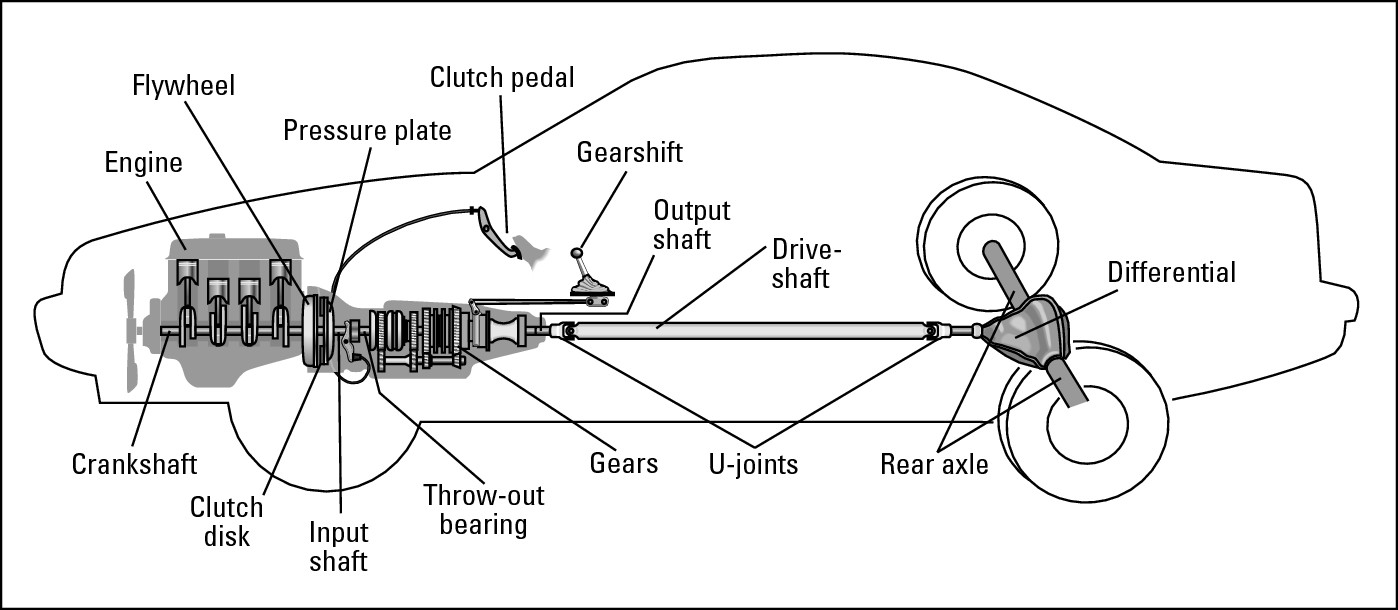
|
Use Figure 18-1 to trace the flow of power from one part of the drive train to the next, as described in the following steps:
1. The running engine produces power that causes the crankshaft to turn at a particular rate of speed. The faster the engine runs, the more power it produces and the faster the crankshaft turns.
2. At the end of the crankshaft is the engine flywheel. This disk-shaped plate turns at the same rate and in the same direction as the crankshaft.
3. Facing the flywheel is the first part of the clutch. When you step on the clutch pedal, the clutch disconnects the engine from the transmission to allow the car to change gears.
4. After you move the gearshift to the proper gear, when you take your foot off the clutch pedal, the clutch allows the engine and transmission to resume contact and turn together at a new speed.
5. On the other side of the clutch, the drive train continues, with a separate shaft. It’s not called the crankshaft anymore; it’s now called the transmission input shaft because it carries the power via the turning shaft into the transmission. It rotates at the same speed and in the same direction as all the parts I’ve covered up to now.
6. Inside the transmission is a group of gears that can move together and apart, in various combinations, to determine how fast and with how much power the vehicle’s wheels turn and whether they go forward, backward, or stop.
7. The next part of the drive train emerges from the other side of the transmission. It’s now called the transmission output shaft because it transmits the power that the transmission is putting out to the driveshaft.
8. The driveshaft of a rear-wheel drive vehicle with a conventional engine has a U-joint (short for universal joint) at either end. The U-joints enable the driveshaft to move freely without affecting the more rigid transmission shaft at one end and to absorb the vertical movement of the rear axle and wheels at its other end.
On vehicles with transverse engines (see Figure 18-2), ball-and-socket fittings called constant velocity joints (CV) transmit engine power from the axles to the wheels. You can find them where each axle joins the transaxle and where each connects with the vehicle’s drive wheels. Like U-joints, they can turn and move in any direction — up, down, and from side to side.
|
Figure 18-2: The flow of power through a transaxle on a front-wheel drive vehicle. |
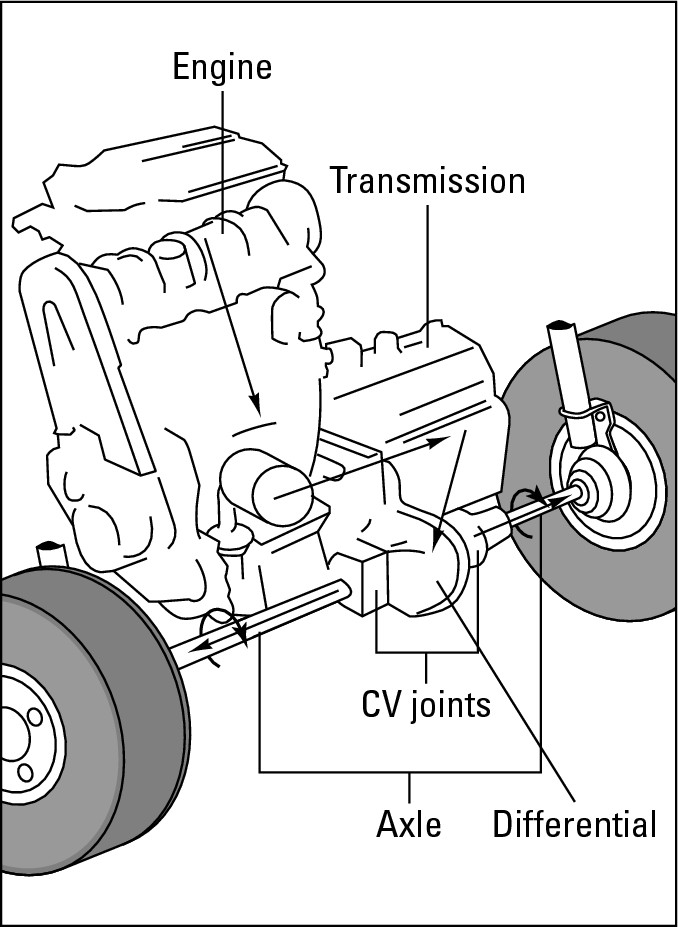
|
9. The differential is another box of gears that, in a rear-wheel drive vehicle (see Figure 18-3), takes the movement of the spinning driveshaft through a 90-degree angle to the axle that turns the drive wheels. It also allows each side of the axle to rotate at a different speed. This ability is necessary because, when you go around a sharp curve, the outside wheel travels farther than the inside wheel and has to move more quickly than the inside wheel, just like the ice skater at the end of a snap-the-whip line.
10. The differential also provides the drive wheels with extra power by using its gears to convert varying numbers of revolutions of the driveshaft into one revolution of the drive wheels. This is called the gear ratio. I get into details about gear ratios in the later section “Manual Transmissions.”
On a front-wheel drive vehicle the transaxle is in line with the center hubs of the front wheels (refer to Figure 18-2). The axles (sometimes called half-shafts) emerge from each end and run straight to the wheels. The differential changes the direction of the power coming out of the engine and into the transaxle.
|
Figure 18-3: The differential on a rear-wheel drive vehicle makes the axle and the rear wheels move at right angles to the spinning driveshaft. |
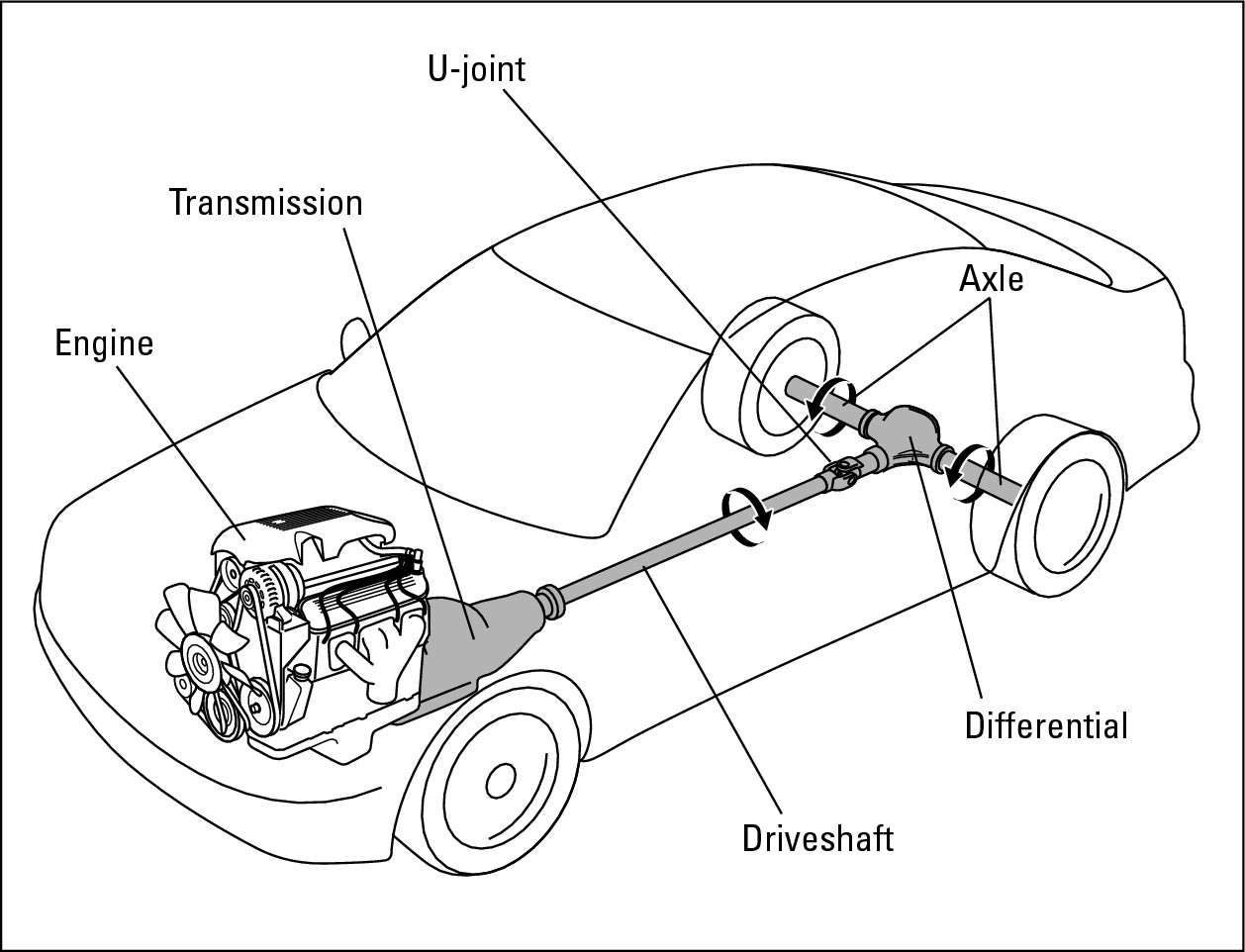
|
Four-wheel drive
If you own a sport-utility vehicle (SUV) that features four-wheel drive (as shown in Figure 18-4), your drive train includes a transfer case (see Figure 18-5). The transfer case controls the power to the front and rear drive axles. When you switch from two- to four-wheel drive with either a dash-mounted switch or a floor-mounted shifter, a gear in the transfer case engages the front driveshaft along with the rear driveshaft so that all four wheels get power from the engine. In two-wheel drive, only the driveshaft connected to the rear wheels gets power from the engine, and the front wheels are disengaged.
The transfer case also usually has settings for low and high gears. Low gear delivers a lot of torque (pulling and pushing power) to the wheels for traveling in very rugged, muddy, snowy, or slippery terrain at slow speeds. High gear is for traveling at moderate speeds on normal roads in wet or moderately slippery conditions. (Your owner’s manual can tell you how fast your vehicle’s system will let you drive without damaging it.)
|
Figure 18-4: A four-wheel drive vehicle has two differentials and a transfer case. |
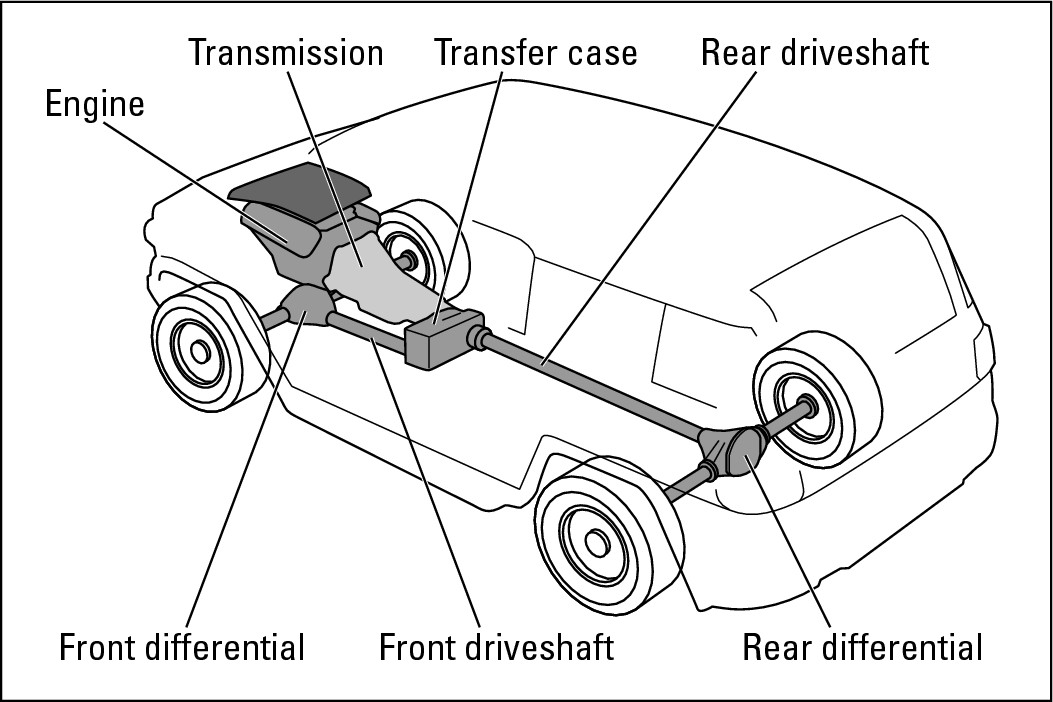
|
|
Figure 18-5: Anatomy of a transfer case. |
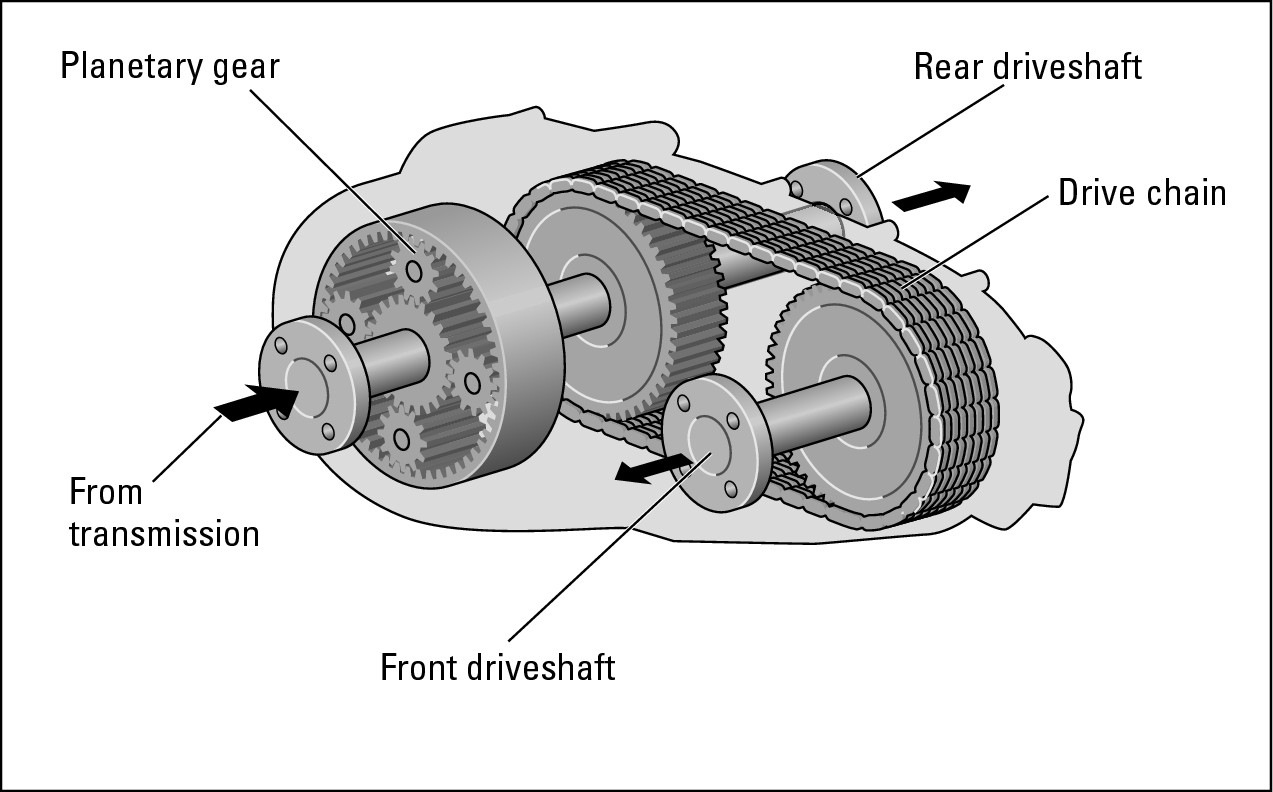
|
All-wheel drive
All-wheel drive (AWD) vehicles are different from four-wheel drive (4WD) vehicles in that AWD vehicles send power to all four wheels all the time. As shown in Figure 18-6, AWD vehicles usually employ three differentials: one between each set of drive wheels and one in the center. They must split the power from the engine to the front and rear wheels for two reasons: because each set travels differently through a turn, and because many systems use computers that sense the amount of traction needed by each wheel and send different amounts of power to each wheel, if necessary.
|
Figure 18-6: An all-wheel drive vehicle has three differentials so the wheels can operate independently of one another. |
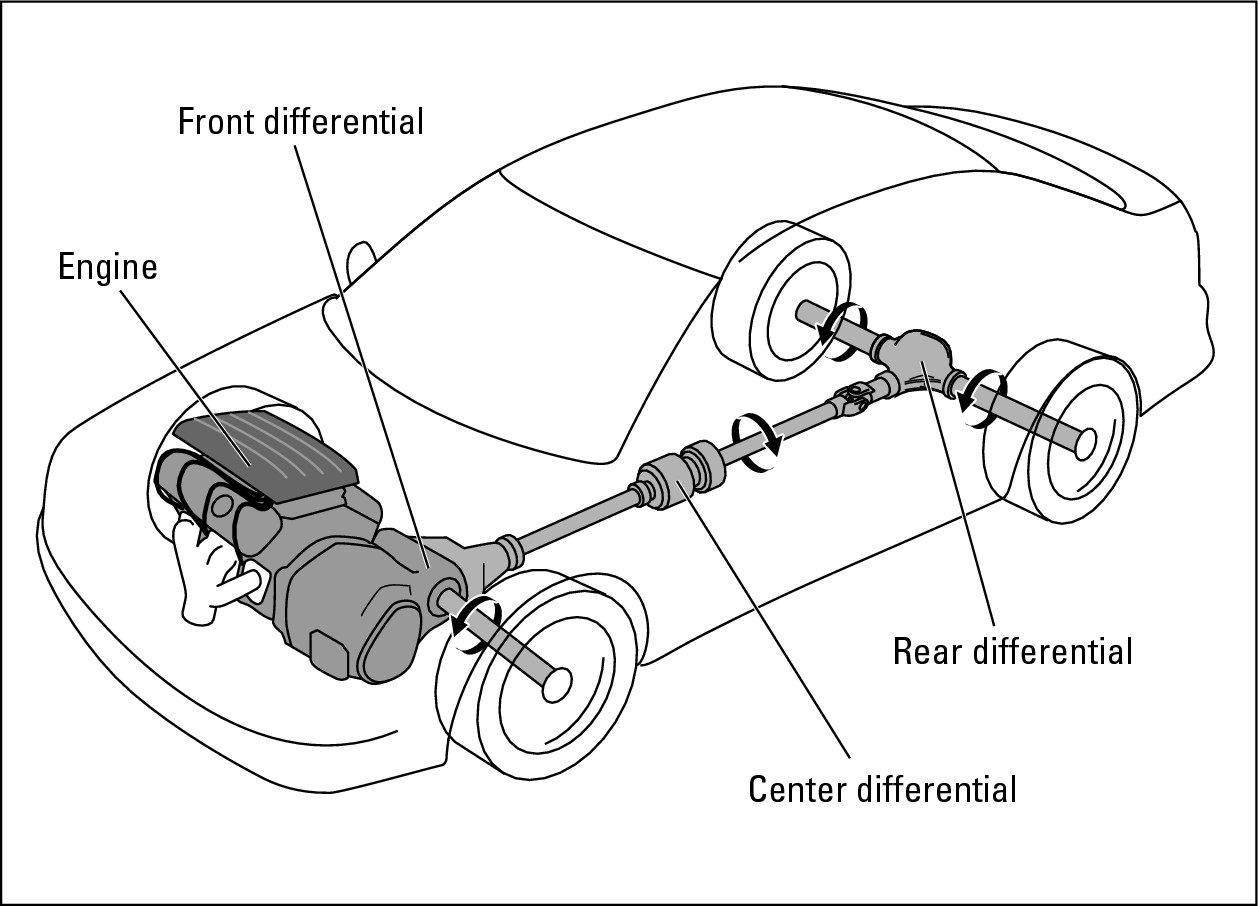
|
Manual Transmissions
Even if your vehicle doesn’t have a manual (sometimes called standard) transmission, you should understand how a manual transmission works. The principles involved are fairly simple, and automatic transmissions do basically the same things, just without a manual clutch and with less manual shifting.
What a manual transmission consists of
This section takes a closer look at each major part of a manual transmission. You encounter most of them in the drive train section earlier in this chapter, but this section puts them into closer perspective.

|
Figure 18-7: Five-speed transmissions are standard on many vehicles. |
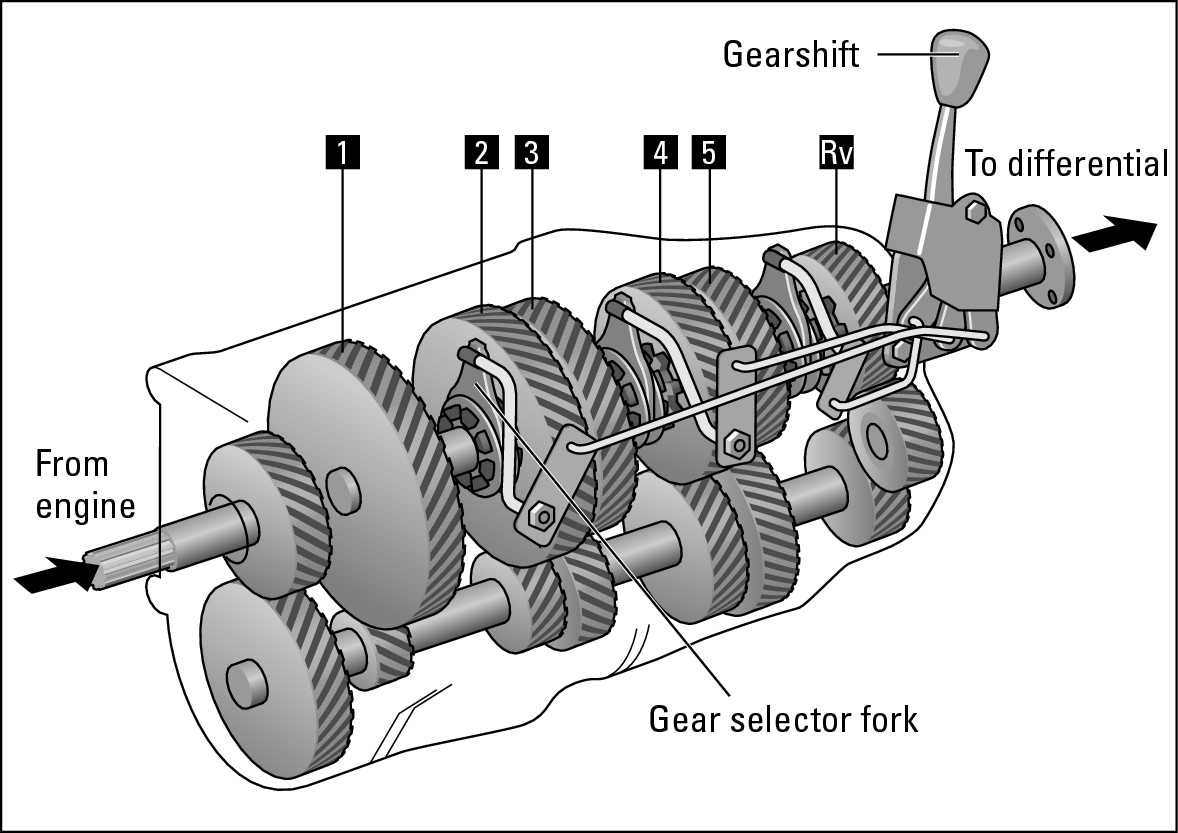
|
The gearshift
You use the gearshift to select and change gears. It’s usually found on the floor in front of or between the front seats. Older cars used to have shifts with three forward speeds located on the steering column. Then sportier models with four forward speeds emerged. The gearshift in those vehicles was located on the floor, which gave rise to the phrase “four on the floor.” Today, vehicles with manual transmissions have as many as seven forward speeds! Gearshifts also have positions for Reverse and Neutral (so the vehicle can idle out of gear).
The clutch
You use the clutch when you start, stop, and shift gears. In each case, you step on the clutch pedal with your left foot to disengage the clutch disk from the engine flywheel so that the engine’s crankshaft can turn independently of the transmission input shaft (the turning shaft that carries the power from the engine into the transmission). If you attempt to shift gears without using the clutch, the gears in the transmission will rotate at different speeds and could clash and injure the transmission. The clutch consists of the following major parts, shown in Figure 18-1:
 The
clutch pedal
is located on the floor of the vehicle to the left of the brake pedal. The clutch pedal is connected to a clutch release lever via linkage. Sometimes a cable is used; most newer cars use
hydraulic
components.
The
clutch pedal
is located on the floor of the vehicle to the left of the brake pedal. The clutch pedal is connected to a clutch release lever via linkage. Sometimes a cable is used; most newer cars use
hydraulic
components.
 The
clutch disk
faces the flywheel. This disk-shaped plate moves back and forth to connect and disconnect the engine from the transmission.
The
clutch disk
faces the flywheel. This disk-shaped plate moves back and forth to connect and disconnect the engine from the transmission.
 The
clutch pressure plate
is next to the clutch disk. This mechanism forces the clutch disk against the flywheel or allows it to move away from the flywheel when it’s time to change gears. When you’re not stepping on the clutch pedal, a coating of friction material causes the disk and the flywheel to adhere to each other, which forces them to turn at the same speed.
The
clutch pressure plate
is next to the clutch disk. This mechanism forces the clutch disk against the flywheel or allows it to move away from the flywheel when it’s time to change gears. When you’re not stepping on the clutch pedal, a coating of friction material causes the disk and the flywheel to adhere to each other, which forces them to turn at the same speed.
 The
throw-out bearing
is linked to the clutch pedal and activates the release levers that move the pressure plate back and forth. When you step on the clutch pedal to disengage the clutch and disconnect the engine from the transmission, a clutch release arm forces the throwout bearing into the pressure plate’s release levers. As a result, the pressure on the clutch disk is released and the disk can turn independently of the flywheel.
The
throw-out bearing
is linked to the clutch pedal and activates the release levers that move the pressure plate back and forth. When you step on the clutch pedal to disengage the clutch and disconnect the engine from the transmission, a clutch release arm forces the throwout bearing into the pressure plate’s release levers. As a result, the pressure on the clutch disk is released and the disk can turn independently of the flywheel.
 After you move the gearshift to the proper gear and the engine is going at its new speed, you release the clutch pedal. This causes springs in the pressure plate to force the clutch disk against the flywheel again. The friction material on the disk causes them to grab each other lovingly and turn at the same rate once more.
After you move the gearshift to the proper gear and the engine is going at its new speed, you release the clutch pedal. This causes springs in the pressure plate to force the clutch disk against the flywheel again. The friction material on the disk causes them to grab each other lovingly and turn at the same rate once more.
The gears
The transmission contains the gears and responds to messages from the gearshift and the clutch. On manual transmissions, the gears are metal wheels with notches on the rims that allow them to mesh with one another (see Figure 18-7). Originally, the gears in most manual transmissions were moved into and out of mesh with each other by the gearshift lever. In modern vehicles, the gears are always in mesh and only the synchronizers move, causing a change in power flow.

How a manual transmission works

On the other hand, if you drive faster than the range of speed provided by a gear, your vehicle will “red line” — go beyond the maximum numbers of rpm (revolutions per minute) your engine is capable of — and damage the engine. That’s why you have to shift up to the next higher gear as your speed increases. The ratio between how fast your engine turns and how fast your wheels turn is called the gear ratio.
Here’s how the gear ratio works: As you can see in Figure 18-8, a large gear is placed next to a small gear so that their teeth mesh. If the large gear has 30 teeth and the small gear has 10, the large gear turns once to every three turns of the small gear. In other words, the large gear turns only a third of the way around for every complete revolution of the small gear. The gears in your transmission work on this principle, which, in this case, is called a 3:1 gear ratio. As you can see in Figure 18-7, the turning drive train brings a gear into contact with other gears of different sizes. That’s why the transmission input shaft that runs between the engine and the transmission turns at the same rate of speed as the engine but the transmission output shaft that leaves the transmission and carries the power via the driveshaft and differential to the rear wheels turns at a different rate, depending on which gears in the transmission are engaged.
|
Figure 18-8: A 3:1 gear ratio: A gear with 10 teeth will have rotated completely when a 30-tooth gear has traveled only a third of the way around. |
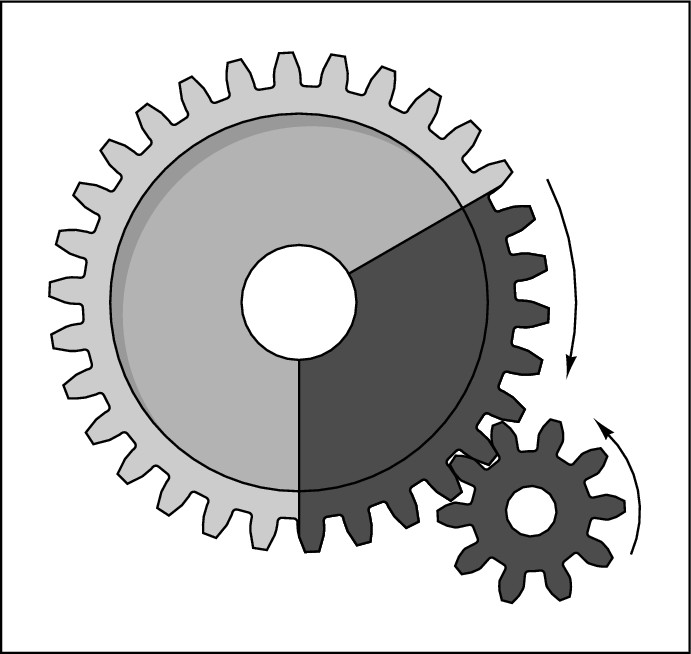
|
If you’re feeling mind-boggled, reread Steps 5 through 10 in “How Power Flows through the Drive Train” earlier in this chapter.
Now take a closer look at what goes on when you shift from one gear to the next.
 In First gear (the lowest gear), the gears in the transmission make the driveshaft (and therefore the wheels) turn more slowly than the engine. In fact, the driveshaft may turn only once for every four engine revolutions (a 4:1 gear ratio). All the power of the swiftly running engine is channeled into those few turns. The wheels turn more slowly, but they have more power to put into each turn, so your vehicle can start, climb a hill, or pull a trailer. Not only does the engine run faster in First gear, but you also have the mechanical advantage of the big gear providing more leverage by turning slowly, but with more force.
In First gear (the lowest gear), the gears in the transmission make the driveshaft (and therefore the wheels) turn more slowly than the engine. In fact, the driveshaft may turn only once for every four engine revolutions (a 4:1 gear ratio). All the power of the swiftly running engine is channeled into those few turns. The wheels turn more slowly, but they have more power to put into each turn, so your vehicle can start, climb a hill, or pull a trailer. Not only does the engine run faster in First gear, but you also have the mechanical advantage of the big gear providing more leverage by turning slowly, but with more force.
 In Second gear, the engine turns more slowly than it did in First, putting out less power but more speed because the wheels can turn more quickly. In this gear, the driveshaft may turn once for every two engine revolutions, or twice as fast as in First gear.
In Second gear, the engine turns more slowly than it did in First, putting out less power but more speed because the wheels can turn more quickly. In this gear, the driveshaft may turn once for every two engine revolutions, or twice as fast as in First gear.
This process continues through each successive gear until the highest one. Every model of vehicle has its own set of gear ratios designed to provide the best combination of power and economy.
 Around Fourth gear, the gear ratio can drop to around 1:1, which means that the engine and the driveshaft turn at relatively the same rate of speed. The wheels can go very fast; yet the engine doesn’t put out additional power to produce that speed. Because you’ve overcome inertia by the time you shift into Fourth gear and generally have nothing more to contend with than wind resistance and the surface of the highway, you don’t need much power to keep moving at a good clip after you get there.
Around Fourth gear, the gear ratio can drop to around 1:1, which means that the engine and the driveshaft turn at relatively the same rate of speed. The wheels can go very fast; yet the engine doesn’t put out additional power to produce that speed. Because you’ve overcome inertia by the time you shift into Fourth gear and generally have nothing more to contend with than wind resistance and the surface of the highway, you don’t need much power to keep moving at a good clip after you get there.
 In Fifth gear, the ratio is usually an
overdrive
of around 0.75:1, which means that the engine can turn more slowly than the output shaft’s speed. You want to be at that ratio on the highway for good fuel economy. However, you need to downshift if you want to gain speed to pass someone because you don’t have much engine power with this ratio.
In Fifth gear, the ratio is usually an
overdrive
of around 0.75:1, which means that the engine can turn more slowly than the output shaft’s speed. You want to be at that ratio on the highway for good fuel economy. However, you need to downshift if you want to gain speed to pass someone because you don’t have much engine power with this ratio.

Some vehicles now have as many as seven gears! Although the ratio may be the same in a seven-speed transmission as in a five-speed, the greater number of gears provides a more precise range of ratios. The more forward speeds, the more precisely power can be applied to the drive wheels and the more fuel-efficient the vehicle becomes.
Automatic Transmissions
Did you know that today’s automatic transmissions are computer- controlled hydraulic systems? Previous automatic transmissions were mechanically controlled. This section covers the basic features of several popular automatic transmission systems.
An automatic transmission works on the same basis as a manual transmission does, with a gear selector on the steering column, dashboard, or floor to allow you to tell your vehicle to park, idle, go into Reverse, go forward at varying speeds, or move into lower gears. But instead of a manual clutch, an automatic transmission uses a torque converter and hydraulic pressure to change gears automatically.
A torque converter replaces the standard transmission’s clutch. The torque converter is a fluid coupling that uses hydraulic pressure to control the amount of engine power transmitted through the converter to the transmission input shaft. It allows the vehicle to idle with the gear selector in Drive, provides a smooth transfer of power, and at highway speeds can be locked up to reduce slippage and improve fuel economy.
Shifting in an automatic transmission is controlled by a hydraulic system that’s usually electronically controlled. Most hydraulically controlled transmissions consist of an intricate network of valves and other components along with hydraulic pressure to control the operation of sets of planetary gears (see Figure 18-9). These gearsets can be fashioned to generate three or more forward speeds. Continuously variable transmissions (CVT) don’t use planetary gears (I get to them later in this chapter).
|
Figure 18-9: A cutaway view of a modern hydraulic automatic transmission. |
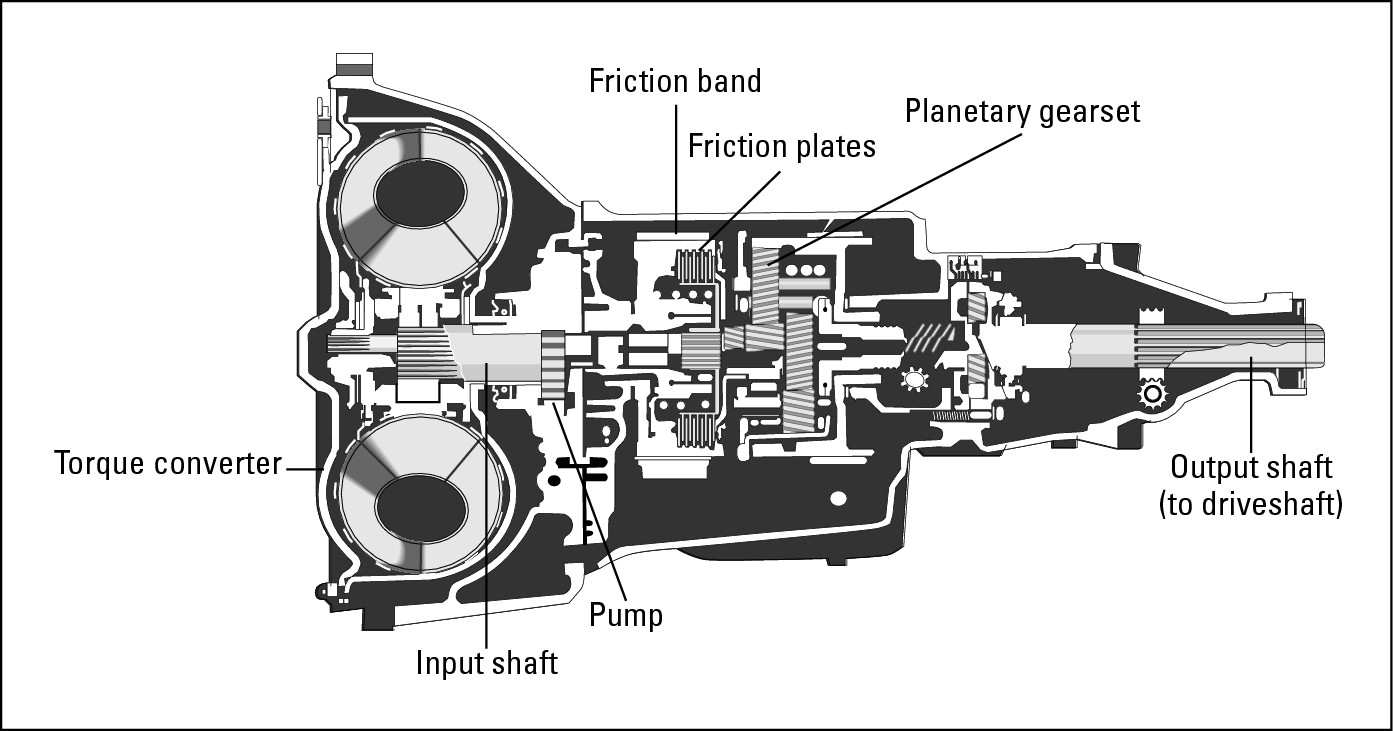
|
A very thin oil called transmission fluid fills the transmission system and generates hydraulic pressure. As the engine speed changes, the pump that pumps the transmission fluid to develop hydraulic pressure also changes speed. The transmission fluid responds to the changes in pressure by flowing through the transmission at different rates. When the vehicle is moving slowly, the pressure is low and only the low gears respond. As the car’s speed increases, so does the pressure, and higher gears are brought into play.
The hydraulic pressure drives the transmission gears by means of friction bands and plates. These bands and plates function like the clutch on a manual transmission, pulling various gears into and out of action. When mechanics tell you that your bands need adjusting, these are the bands they’re talking about. They usually can make this adjustment without taking the transmission apart.
Electronic transmission systems use a computer called a transmission controller to keep track of engine speed, acceleration, load (as when you’re driving up a hill), and braking. It uses this information to send electronic messages to solenoids that control shifting.

Dual-clutch transmissions
Originally, prospective car-buyers had two basic options when choosing a transmission: manual or automatic. Now there’s a third type that offers the driver the best features of both in a single vehicle! You can kick back and let your vehicle shift gears automatically, or you can manually select them yourself without the need to operate a clutch pedal. These nifty transmissions are known by a variety of names: dual-clutch, automated manual, semi- automatic, even “clutchless” (which makes no sense since they have two clutches instead of one!). To stay sane, I call them dual-clutch transmissions, or DCT for short. DCTs operate more smoothly than ordinary automatics or manuals, and they can deliver better fuel economy, as well.
As you can see in Figure 18-10, the most significant structural difference is that a DCT has two clutches (hence the name “dual-clutch”). One clutch operates the odd-numbered gears, and the other clutch controls the even-numbered gears. The result is that the flow of power to the transmission from the engine isn’t interrupted as the transmission shifts from one gear to another.
The DCT also has two transmission input shafts, one inside the other. The hollow outer shaft contacts the even-numbered gears, and the shaft inside it contacts the odd-numbered gears.
DCTs don’t use torque converters; instead, most of them use “wet” clutches to hydraulically operate the gears, as most automatic transmissions do. This also lubricates them to cut down friction and heat. “Dry” clutches similar to the ones in manual transmissions will probably be available, too.
|
Figure 18-10: A dual-clutch transmission has two clutches and two transmission shafts. |
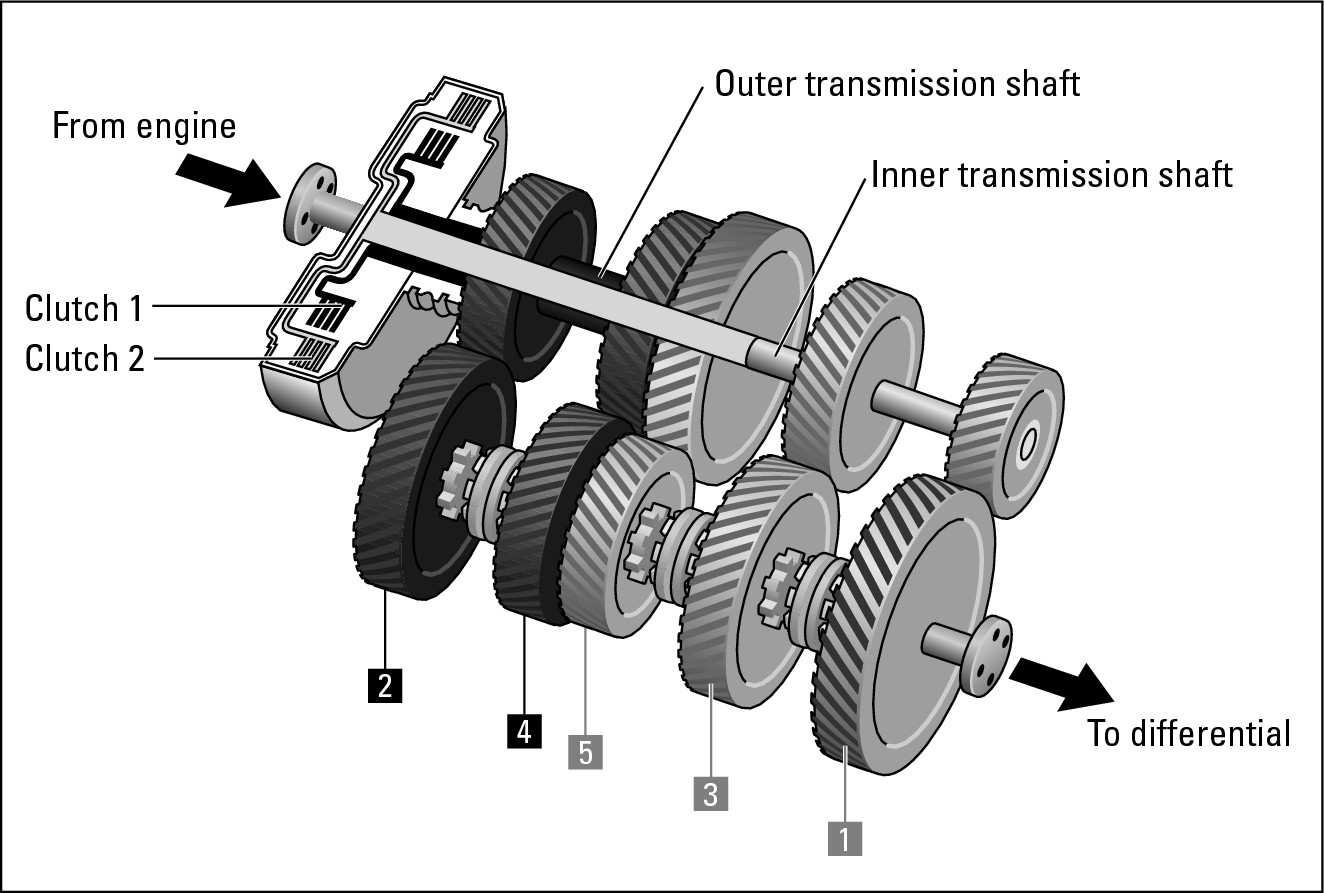
|

Continuously variable transmissions
Newer vehicles are now available with continuously variable transmissions (or CVT, for short) that have no physical gears at all! Instead, they move seamlessly from one gear ratio to the next by means of a pulley system that not only provides for smoother shifting but also results in higher fuel efficiency.

CVTs aren’t complicated systems. They may use hydraulic pressure, springs, or centrifugal force to adjust gear ratio in response to information collected by sensors and sent to a computer. Most of them consist of an input drive pulley that’s connected to the engine crankshaft and brings energy into the transmission from the engine. An output pulley (or driven pulley) sends the energy out of the transmission to the driveshaft. (It’s called “driven” because the input pulley drives it.)
As you can see in Figure 18-11, each pulley consists of two cones and a belt that rides in a groove between them. As the distance between the cones changes, the belt rides higher or lower in the groove. Where it’s riding changes the radius of the belt’s loop around each pulley, and its position on each pulley (its radius) determines the gear the vehicle is in.
|
Figure 18-11: A continuously variable transmission system consists of two pulleys and a belt. |
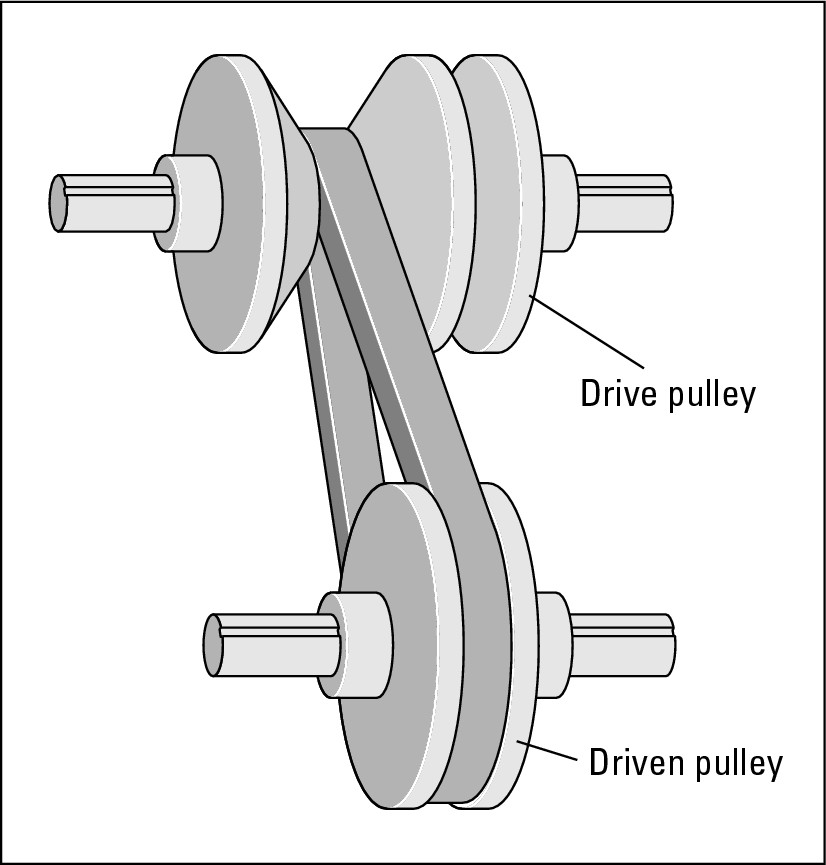
|
CVTs are constantly evolving. Newer versions employ quieter and longer- lasting flexible metal belts that connect butterfly-shaped metal pieces and systems that use disks and power rollers, but the advantages remain the same: faster response time, greater power, smoother shifting, higher efficiency, and fuel economy. CVTs currently may be more expensive than traditional transmissions, but they’re worth it.
Troubleshooting Your Drive Train
Did you know that a low transmission fluid level or a malfunctioning, inexpensive gizmo may cause the same symptoms as a faulty transmission? Who knows how many unsuspecting customers have paid big bucks to rebuild or replace transmissions when they could have corrected the problems themselves with very little money or effort! This section shows you how to troubleshoot your transmission and try the cheapest remedies before paying professionals to do major surgery.
If you have to take the problem to a specialist, be sure to read the section called “Undertaking Transmission Repairs Wisely” later in this chapter. If you’re lucky, your transmission may need only a simple adjustment. If you’re not so lucky, your transmission may need to be rebuilt or replaced. But in any event, you’ll know that you’re getting the proper service.
Symptoms of a sick transmission system
If weird things start happening on the road, how can you tell whether the transmission or one of the other parts of the drive train is in trouble? If this is the case, continuing to drive may make the situation worse. Here are ways your vehicle tries to tip you off:
 If light grey smoke is coming out of the tailpipe, this can mean you’re low on
transmission fluid
and the engine could be burning. Check the following section to beat “Those low-transmission-fluid blues.”
If light grey smoke is coming out of the tailpipe, this can mean you’re low on
transmission fluid
and the engine could be burning. Check the following section to beat “Those low-transmission-fluid blues.”

In some pre-1990 vehicles, the smoke may also be due to a faulty vacuum modulator that’s siphoning the fluid out of the transmission and into cylinders of the hot engine. Consult a service manual for your make, model, and year to see if Old Faithful has a vacuum modulator; if it’s easy to reach, try unscrewing it and replacing it before you consider more costly remedies.
In most post-1990 vehicles with automatic transmissions, the vacuum modulator has been replaced by an electronic solenoid. It does the same job but is controlled by the electronic control unit (ECU) rather than engine vacuum, so there’s no siphoning problem.
 If thick, black or tan, oily liquid is coming from under the vehicle, gear oil may be leaking from a
manual transmission,
the
differential,
an
axle,
or the steering gears. Any of these leaks needs immediate attention.
If thick, black or tan, oily liquid is coming from under the vehicle, gear oil may be leaking from a
manual transmission,
the
differential,
an
axle,
or the steering gears. Any of these leaks needs immediate attention.
 If the engine speeds up when you step on the accelerator but your vehicle doesn’t; or if it hesitates before responding when you shift gears (or doesn’t respond at all); or if shifting suddenly becomes awkward or noisy, the cause depends on whether you have an automatic or manual transmission. If you have an
automatic transmission,
you may just be low on
transmission fluid,
have a disconnected hose or plugged filter, or your
transmission controller
may be out of whack. If you have a
manual transmission,
the trouble could be in the
clutch
or another component. In any case, it’s a job for the car doctor.
If the engine speeds up when you step on the accelerator but your vehicle doesn’t; or if it hesitates before responding when you shift gears (or doesn’t respond at all); or if shifting suddenly becomes awkward or noisy, the cause depends on whether you have an automatic or manual transmission. If you have an
automatic transmission,
you may just be low on
transmission fluid,
have a disconnected hose or plugged filter, or your
transmission controller
may be out of whack. If you have a
manual transmission,
the trouble could be in the
clutch
or another component. In any case, it’s a job for the car doctor.
 If you hear a clunking sound, it can mean transmission trouble or just a low fluid level. If a loud clunking suddenly comes from under the hood, it could be just a broken
accessory belt.
In either case, pull to the side of the road and call for a tow.
If you hear a clunking sound, it can mean transmission trouble or just a low fluid level. If a loud clunking suddenly comes from under the hood, it could be just a broken
accessory belt.
In either case, pull to the side of the road and call for a tow.
Those low-transmission-fluid blues
If your automatic transmission seems to be acting up by hesitating when you change gears or by shifting with a “clunk,” first check your transmission dipstick. Your transmission fluid may be low or dirty. Chapter 2 tells you how to find and check your transmission dipstick and how to buy the proper kind of transmission fluid for your vehicle.

 If your fluid level is low, with the
parking brake
on and the
gearshift
in Neutral or Park, use a funnel to add a teeny bit of fluid at a time down the dipstick hole until the fluid level just reaches the “Full” line on the stick.
If your fluid level is low, with the
parking brake
on and the
gearshift
in Neutral or Park, use a funnel to add a teeny bit of fluid at a time down the dipstick hole until the fluid level just reaches the “Full” line on the stick.
.jpg)
Do not fill beyond the line! Driving with too much transmission fluid can damage your transmission. Check the stick again in a couple of days; if the level is low again, you either have a leak or may need to have a seal replaced.
To check for a leak, before you drive off in the morning look at the ground under the vehicle for a greasy red, pink, or reddish-brown leak around the transmission area — or on the transmission itself, if you can see it easily. (If you have a rear-wheel, four-wheel, or all-wheel drive vehicle, to get a look at the transmission you’ll probably have to jack up your vehicle or have a professional place it on a hoist.)
 If your fluid level is fine but your transmission isn’t working well; or if your fluid keeps disappearing and no leaks are evident, you probably need transmission work.
If your fluid level is fine but your transmission isn’t working well; or if your fluid keeps disappearing and no leaks are evident, you probably need transmission work.
 If the transmission fluid on the dipstick looks or smells burned or dirty, you may want to consider having the fluid, filter, and the pan
gasket
changed.
If the transmission fluid on the dipstick looks or smells burned or dirty, you may want to consider having the fluid, filter, and the pan
gasket
changed.
.jpg)



Taking Care of Your Clutch
Most drivers can expect their clutches to last 40,000 to 60,000 miles but your clutch can be good for as little as a few thousand miles or as long as the life of your vehicle depending on the type of vehicle you drive, the way you drive it, and how much maintenance it receives.
Most newer vehicles with manual transmissions have self-adjusting clutches that require no adjustment, but if you have an older model without self-adjustment, you can cut down on the wear on your clutch disk by keeping your clutch pedal properly adjusted. (If you’ve forgotten, the “What a manual transmission consists of” section earlier in this chapter tells you what these parts are and what they look like.)

If there’s no free pedal play on your clutch pedal, another problem can occur, even if there’s enough play to allow the clutch disk to engage. In this case, the throwout bearing, which responds to pressure on the clutch pedal by causing the disk to disengage, may go on spinning. If the throwout bearing is allowed to revolve constantly in this way, it will wear out, which makes getting into or out of gear difficult.


 If the flywheel is worn, have a professional resurface it. This procedure involves grinding it down to a new, flat surface and then polishing it to a mirror-like finish. If you fail to have this work done, the worn flywheel can wear out the facing of the new clutch disk very quickly. And if you’ve already had the disk replaced, chances are that it managed to score the flywheel by the time you recognized the trouble signs and had the disk attended to.
If the flywheel is worn, have a professional resurface it. This procedure involves grinding it down to a new, flat surface and then polishing it to a mirror-like finish. If you fail to have this work done, the worn flywheel can wear out the facing of the new clutch disk very quickly. And if you’ve already had the disk replaced, chances are that it managed to score the flywheel by the time you recognized the trouble signs and had the disk attended to.
 If the pressure plate is excessively worn, scored, or glazed; or if the springs on the pressure plate become loose, you should have them replaced, as well.
If the pressure plate is excessively worn, scored, or glazed; or if the springs on the pressure plate become loose, you should have them replaced, as well.

Undertaking Transmission Repairs Wisely
Your first line of defense against unnecessary transmission work is to have your automatic transmission serviced periodically, according to the manufacturer’s recommendations (usually around every 24,000 miles). Your second line of defense is to understand what the basic kinds of transmission work involve. Here are the various types of work that your vehicle may require and what each of them entails:
 If your transmission needs servicing:
If your transmission needs servicing:
• The transmission fluid should be changed, if necessary.
• The bands on a hydraulic transmission should be adjusted, if this job can be done externally.
• The transmission filter should be replaced.
• The gasket around the transmission pan should be replaced, and the fluid in the pan should be changed.
 If your transmission is leaking:
If your transmission is leaking:
• If the front seal is bad, the technician must remove your transmission to replace it, but he or she doesn’t have to take the transmission apart. Front seals usually have the biggest leaks.
• If the problem is the rear seal, the technician must remove your driveshaft, but your transmission can stay in place.
 If your transmission must be overhauled:
If your transmission must be overhauled:
• The transmission should be removed and disassembled.
• The seals, clutches, bands, and bushings that are worn or defective should be replaced.

 If your transmission must be replaced:
The old transmission must be removed and a new one installed. You do have an option as to whether you replace it with a used,
rebuilt,
or new transmission. I make the distinction between used and rebuilt because you can buy a transmission from a wrecking yard that has salvaged one designed for your vehicle’s year, make, and model. This option is cheap, but risky. Your other option is to find a rebuilt transmission that has been salvaged and then completely refurbished and comes with at least a three-month
guarantee.
These cost a bit more, but you get a chance to make sure that the thing is in good working order.
If your transmission must be replaced:
The old transmission must be removed and a new one installed. You do have an option as to whether you replace it with a used,
rebuilt,
or new transmission. I make the distinction between used and rebuilt because you can buy a transmission from a wrecking yard that has salvaged one designed for your vehicle’s year, make, and model. This option is cheap, but risky. Your other option is to find a rebuilt transmission that has been salvaged and then completely refurbished and comes with at least a three-month
guarantee.
These cost a bit more, but you get a chance to make sure that the thing is in good working order.
Occasionally, gearshifts may become hard to move. This problem can happen if the gearshift linkage, which connects the shift lever to the rods that go to the transmission, needs adjustment, lubrication, or minor repair. These repairs aren’t expensive and should certainly be investigated before you let anyone talk you into major transmission work.
Front-wheel drive vehicles have a transmission and axle assembly all in one, called a transaxle. All-wheel drive and four-wheel drive vehicles usually have an additional component called a transfer case. Expect to pay more for transaxle repairs and transmission repairs on a vehicle with a transfer case.



 For transmission repairs, take your vehicle to the dealership or to a reputable transmission specialist. Ask the technician to diagnose the trouble and give you an estimate of the costs.
For transmission repairs, take your vehicle to the dealership or to a reputable transmission specialist. Ask the technician to diagnose the trouble and give you an estimate of the costs.
 Don’t let the technician take the transmission apart. When your transmission is in pieces, you’re a sitting duck! Have the specialist drive the vehicle, listen to it, ask you questions about its history and its symptoms, and give you his or her ideas. The technician may say, “You may just need your transmission serviced, or you may need a new transmission; I can’t tell until I open it up.” Fine. Ask for estimates for both jobs, and if the prognosis is expensive, get additional estimates. You’d get a second opinion before going through major surgery, wouldn’t you?
Don’t let the technician take the transmission apart. When your transmission is in pieces, you’re a sitting duck! Have the specialist drive the vehicle, listen to it, ask you questions about its history and its symptoms, and give you his or her ideas. The technician may say, “You may just need your transmission serviced, or you may need a new transmission; I can’t tell until I open it up.” Fine. Ask for estimates for both jobs, and if the prognosis is expensive, get additional estimates. You’d get a second opinion before going through major surgery, wouldn’t you?
How to Keep from Driving Your Transmission Crazy
Driving your vehicle with expertise can prevent many of the most common causes of transmission failure. If you have a manual transmission, you should shift into the proper gear at the proper time to reduce the strain on the engine and the transmission and should not ride your clutch. To do this, a good driver with a manual transmission learns to watch the tachometer, or just “feel” the vehicle’s need for more power or more speed, and then shift into the proper gear for each occasion.
Many drivers with automatic transmissions just shift into Drive and go up steep hills, carry heavy loads, and bounce into jackrabbit starts, happily oblivious to the fact that even automatic transmissions have gear selectors that provide one or two lower gears for these occasions. On the other hand, if you stay in a low gear unnecessarily, you’re transmitting excessive power to your rear wheels, and your transmission feels the strain. If you attempt to speed in a low gear, you strain the transmission even more. On the other hand, if you attempt to climb hills in high gear, you force the engine and transmission to make the effort in a gear that lacks the power for the job. The result: more strain.

 When you need a sudden burst of speed, use passing gear.
On vehicles with an automatic transmission, passing gear provides the same kind of increased power as
downshifting
a manual transmission. You use passing gear when you’re already in high gear and need an extra burst of power to pass a car or enter a freeway. If you’ve been traveling at less than 50 mph, suddenly flooring the
accelerator
makes your car downshift automatically to the appropriate lower gear to provide more power by speeding up the engine.
When you need a sudden burst of speed, use passing gear.
On vehicles with an automatic transmission, passing gear provides the same kind of increased power as
downshifting
a manual transmission. You use passing gear when you’re already in high gear and need an extra burst of power to pass a car or enter a freeway. If you’ve been traveling at less than 50 mph, suddenly flooring the
accelerator
makes your car downshift automatically to the appropriate lower gear to provide more power by speeding up the engine.
 Use Overdrive (or the highest gear on a manual transmission) when you’re traveling steadily at a high speed. With Overdrive or “top” gear, you have an extra, higher gear that allows your rear wheels to turn even faster while maintaining the same engine speed. After you’re really moving, shifting into Overdrive means that you can move at the same speed while the engine turns more slowly and consumes less fuel.
Use Overdrive (or the highest gear on a manual transmission) when you’re traveling steadily at a high speed. With Overdrive or “top” gear, you have an extra, higher gear that allows your rear wheels to turn even faster while maintaining the same engine speed. After you’re really moving, shifting into Overdrive means that you can move at the same speed while the engine turns more slowly and consumes less fuel.
 Shift manual transmissions to higher gears as soon as your speed enters their range. There’s no need to supply extra power when it’s not needed. Your owner’s manual should tell you the range of speed for each gear. Automatic transmissions shift for you.
Shift manual transmissions to higher gears as soon as your speed enters their range. There’s no need to supply extra power when it’s not needed. Your owner’s manual should tell you the range of speed for each gear. Automatic transmissions shift for you.
 If traffic slows and you feel the engine straining (called lugging), shift manual transmissions into a lower gear. Downshifting enables the engine to turn faster and carry you along with less strain. After you’re moving freely again, return to a higher gear.
If traffic slows and you feel the engine straining (called lugging), shift manual transmissions into a lower gear. Downshifting enables the engine to turn faster and carry you along with less strain. After you’re moving freely again, return to a higher gear.
 With both types of transmissions, select lower gears for heavy loads and steep hills. If you come to a steep hill — or if you’re carrying four kids, two dogs, and everything you’ll need for a month in the country — go for the lower gears instead of trying to haul the whole mess as fast as you can. Then shift back up again to coast down the hill. This way, the power goes toward carrying the load rather than toward maintaining speed.
With both types of transmissions, select lower gears for heavy loads and steep hills. If you come to a steep hill — or if you’re carrying four kids, two dogs, and everything you’ll need for a month in the country — go for the lower gears instead of trying to haul the whole mess as fast as you can. Then shift back up again to coast down the hill. This way, the power goes toward carrying the load rather than toward maintaining speed.
